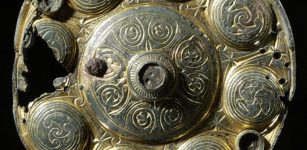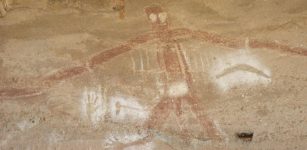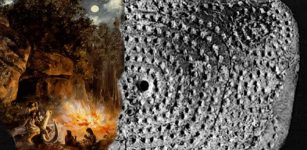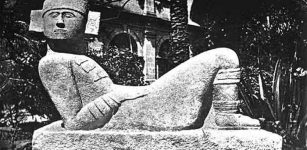Ancient Mystery Of The Leo Petroglyphs In Ohio Created By An Unknown Native American Culture
Jan Bartek - AncientPages.com - Perched on a ridge near the small village of Leo in Jackson County, Ohio there are curious ancient petroglyphs that remain an unsolved ancient mystery.
The sandstone petroglyphs containing 37 images of humans, birds, animal, and human footprints, a fish, a snake, and other figures are a legacy of an unknown Native American culture. When scientists examined this ancient art, they realized there were two questions they could not answer.
Sandstone petroglyph near the village of Leo, Jackson County, Ohio. Image source
For one thing, researchers have been unable to identify the creators of these remarkable carvings. Another problem is the fact scientists cannot determine the meaning of these images. Were the petroglyphs deliberately made to depict daily life or do these carvings have a symbolic meaning?
The exact age of the petroglyphs found on the edge of an unglaciated Mississippian sandstone cliff 20–65 feet high remains undetermined, but it’s believed the carvings are about 1,000-year-old.
It has been suggested the carvings were made by the Fort Ancient culture, 1000 to 1650 A.D. that thrived in the areas of modern-day southern Ohio, northern Kentucky, southeastern Indiana, and western West Virginia. There is not much information about the Fort Ancient culture but is known these people were primarily farmers and hunters who lived in villages that had many circular or rectangular houses surrounding an open plaza.
View of the The Great Serpent Mound, one of the most important prehistoric effigy mound of Adema Culture, located on the Ohio river, Ohio, USA. Credit: Timothy A. Price and Nichole I - CC BY-SA 3.0
To begin with, they buried their dead in small burial mounds, but later their burial traditions changed, and they put to rest the deceased in a cemetery with no burial mounds. The Fort Ancient culture is perhaps most famous for the creation of the magnificent and great Serpent Mound of Ohio that is one of the most famous ancient earthworks of Most Famous North America.
Though other serpent mounds can be found in Mexico, Scotland, and Canada, Ohio's serpent mound is by far the largest and most interesting serpent mound in the world. One must add there is no conclusive evidence the Serpent Mound is a legacy of the Fort Ancient culture, but most scientists think these people were in fact the creators of this impressive ancient earthwork.
What are these images supposed to represent? Image source
This assumption has also led many to speculatee the Leo petroglyphs in Ohio were also made by the Fort Ancient culture, but we do not know this was the case with certainty.
Some of the Leo Petroglyphs suggest creators of these carvings were in contact with Europeans. This is interesting because although there are no historical records of contact between the Fort Ancient culture and the Europeans scientists have discovered a remarkable amount of European made goods from Fort Ancient sites, including brass and steel items, as well as glassware. The Fort Ancients were heavily affected by European disease, as well as the Beaver Wars period. This Native American culture vanished, but gradually.
Leo Petroglyph, face with headdress. Image source
Some of the mysterious Leo petroglyphs are exceedingly difficult to understand. Whoever did these carvings must have wanted to tell future generations something. Unless the petroglyphs were just produced as entertainment of course. What could be the meaning and purpose of some of these more abstract designs, including one that looks like a cartoon man with horns?
Written by Jan Bartek - AncientPages.com Staff Writer
Updated on July 20, 2024
Copyright © AncientPages.com All rights reserved. This material may not be published, broadcast, rewritten or redistributed in whole or part without the express written permission of AncientPages.com
Expand for referencesMore From Ancient Pages
-
 Ancient Runestones Reveal A Surprising Viking Secret – Scientists Say
Featured Stories | Jul 21, 2024
Ancient Runestones Reveal A Surprising Viking Secret – Scientists Say
Featured Stories | Jul 21, 2024 -
 10 Surprising Facts About The Neanderthals Who Were Not As Primitive As Previously Thought
Ancient History Facts | May 6, 2017
10 Surprising Facts About The Neanderthals Who Were Not As Primitive As Previously Thought
Ancient History Facts | May 6, 2017 -
 Forgotten Ancient Empire That Extended Far Beyond America To Iceland And Its Mysterious Inscriptions
Ancient Mysteries | May 6, 2021
Forgotten Ancient Empire That Extended Far Beyond America To Iceland And Its Mysterious Inscriptions
Ancient Mysteries | May 6, 2021 -
 Dark History Of Pömmelte, The German Stonehenge – What Can The Nebra Sky Disc And Archaeology Reveal?
Archaeology | Jul 3, 2018
Dark History Of Pömmelte, The German Stonehenge – What Can The Nebra Sky Disc And Archaeology Reveal?
Archaeology | Jul 3, 2018 -
 Fragments Of 6,500-Year-Old Figurine Of ‘Venus of Egerszeg’ – Unearthed
Archaeology | Jul 21, 2020
Fragments Of 6,500-Year-Old Figurine Of ‘Venus of Egerszeg’ – Unearthed
Archaeology | Jul 21, 2020 -
 Magnificent St. Paul’s Catacombs – Largest Underground Roman Cemetery In Malta
Featured Stories | Aug 28, 2019
Magnificent St. Paul’s Catacombs – Largest Underground Roman Cemetery In Malta
Featured Stories | Aug 28, 2019 -
 On This Day In History: Great Fire Of London Ends – On Sep 5/6, 1666
News | Sep 5, 2016
On This Day In History: Great Fire Of London Ends – On Sep 5/6, 1666
News | Sep 5, 2016 -
 Viking’s Symbols Of Travels Prestige And Adventure Were Imported From Abroad
Ancient Symbols | Oct 1, 2015
Viking’s Symbols Of Travels Prestige And Adventure Were Imported From Abroad
Ancient Symbols | Oct 1, 2015 -
 7,000-Year-Old Underwater Road Discovered In Adriatic Sea Off Korcula Island
Archaeology | May 11, 2023
7,000-Year-Old Underwater Road Discovered In Adriatic Sea Off Korcula Island
Archaeology | May 11, 2023 -
 ‘Dates Add Nothing To Our Culture’: Everywhen Explores Indigenous Deep History, Challenging Linear, Colonial Narratives
Featured Stories | Mar 10, 2023
‘Dates Add Nothing To Our Culture’: Everywhen Explores Indigenous Deep History, Challenging Linear, Colonial Narratives
Featured Stories | Mar 10, 2023 -
 On This Day In History: Battle Of Rudau Was Fought – On Feb 17, 1370
News | Feb 17, 2017
On This Day In History: Battle Of Rudau Was Fought – On Feb 17, 1370
News | Feb 17, 2017 -
 Daily Life Of A Lady In Waiting – A Dangerous Profession Sometimes
Ancient History Facts | Aug 24, 2023
Daily Life Of A Lady In Waiting – A Dangerous Profession Sometimes
Ancient History Facts | Aug 24, 2023 -
 The Assyrian Siege Ramp And Breached Walls At Canaanite City Of Lachish – Studied
Archaeology | Nov 10, 2021
The Assyrian Siege Ramp And Breached Walls At Canaanite City Of Lachish – Studied
Archaeology | Nov 10, 2021 -
 Ancient Clay Tablets Reveal Mesopotamians Experienced Emotions In Their Bodies Differently Than Modern Humans
Archaeology | Dec 6, 2024
Ancient Clay Tablets Reveal Mesopotamians Experienced Emotions In Their Bodies Differently Than Modern Humans
Archaeology | Dec 6, 2024 -
 Unusual Relic That Mysteriously Disappeared From The Vatican
Ancient Mysteries | Nov 8, 2018
Unusual Relic That Mysteriously Disappeared From The Vatican
Ancient Mysteries | Nov 8, 2018 -
 Why Were Actors Painted As Cats By Ukiyo-e Artists In Japan?
Ancient History Facts | Feb 11, 2020
Why Were Actors Painted As Cats By Ukiyo-e Artists In Japan?
Ancient History Facts | Feb 11, 2020 -
 Skeleton Of Last Trojan Discovered – Ancient City Of Troy May Have Been A Religious Sanctuary – Archaeologists Say
Archaeology | Sep 21, 2018
Skeleton Of Last Trojan Discovered – Ancient City Of Troy May Have Been A Religious Sanctuary – Archaeologists Say
Archaeology | Sep 21, 2018 -
 Astonishing Lunar And Solar Calendars Created 30,000 B.C.
Artifacts | Aug 8, 2017
Astonishing Lunar And Solar Calendars Created 30,000 B.C.
Artifacts | Aug 8, 2017 -
 On This Day In History: Battle Of Cowpens Took Place – On Jan 17, 1781
News | Jan 17, 2017
On This Day In History: Battle Of Cowpens Took Place – On Jan 17, 1781
News | Jan 17, 2017 -
 Chacmool (‘Chac-Mool’) – Intriguing Pre-Columbian Statue Found At Many Ancient Sites In Mesoamerica
Featured Stories | May 22, 2021
Chacmool (‘Chac-Mool’) – Intriguing Pre-Columbian Statue Found At Many Ancient Sites In Mesoamerica
Featured Stories | May 22, 2021




